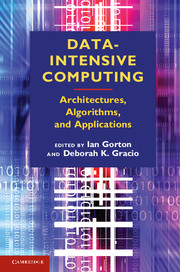Book contents
- Frontmatter
- Contents
- List of Contributors
- 1 Data-Intensive Computing: A Challenge for the 21st Century
- 2 Anatomy of Data-Intensive Computing Applications
- 3 Hardware Architectures for Data-Intensive Computing Problems: A Case Study for String Matching
- 4 Data Management Architectures
- 5 Large-Scale Data Management Techniques in Cloud Computing Platforms
- 6 Dimension Reduction for Streaming Data
- 7 Binary Classification with Support Vector Machines
- 8 Beyond MapReduce: New Requirements for Scalable Data Processing
- 9 Let the Data Do the Talking: Hypothesis Discovery from Large-Scale Data Sets in Real Time
- 10 Data-Intensive Visual Analysis for Cyber-Security
- Index
- References
8 - Beyond MapReduce: New Requirements for Scalable Data Processing
Published online by Cambridge University Press: 05 December 2012
- Frontmatter
- Contents
- List of Contributors
- 1 Data-Intensive Computing: A Challenge for the 21st Century
- 2 Anatomy of Data-Intensive Computing Applications
- 3 Hardware Architectures for Data-Intensive Computing Problems: A Case Study for String Matching
- 4 Data Management Architectures
- 5 Large-Scale Data Management Techniques in Cloud Computing Platforms
- 6 Dimension Reduction for Streaming Data
- 7 Binary Classification with Support Vector Machines
- 8 Beyond MapReduce: New Requirements for Scalable Data Processing
- 9 Let the Data Do the Talking: Hypothesis Discovery from Large-Scale Data Sets in Real Time
- 10 Data-Intensive Visual Analysis for Cyber-Security
- Index
- References
Summary
Introduction and Background
The MapReduce programming model has had a transformative impact on dataintensive computing, enabling a single programmer to harness hundreds or thousands of computers for a single task and get up and running in a matter of hours. Processing with thousands of computers require a different set of design considerations dominate: I/O scalability, fault tolerance, and flexibility rather than absolute performance. MapReduce, and the open-source implementation Hadoop, are optimized for these considerations and have become very successful as a result.
It is difficult to quantify the popularity of the MapReduce framework directly, but one indication of the uptake is the frequency of the search term. Figure 8.1 illustrates the search popularity for terms “mapreduce” and “hadoop” over the period 2006 to 2012. We see a spike in popularity for the term “mapreduce” in late 2007, but more or less constant popularity since. For the term “hadoop,” however, we see a steady increase to about twelve times that of “mapreduce.”
These data suggest that MapReduce and Hadoop are generating interest, as seen from the number of downloads, successful startups [12, 19, 47], projects [41, 53, 57], and interest from the research community [15, 18, 62, 63, 72, 78]. These data suggest a significant increase in interest in both MapReduce and Hadoop.
The MapReduce framework provides a simple programming model for expressing loosely coupled parallel programs by providing two serial functions, Map and Reduce. The Map function processes a block of input producing a sequence of (key, value) pairs, while the Reduce function processes a set of values associated with a single key.
- Type
- Chapter
- Information
- Data-Intensive ComputingArchitectures, Algorithms, and Applications, pp. 180 - 234Publisher: Cambridge University PressPrint publication year: 2012
References
- 1
- Cited by

